- info@aromantique.co.uk
- 07419 777 451
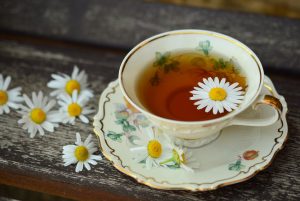
Herbal tea: infusion of herbs brewed in boiling water. For example, add one tablespoon of dried herb to 8 fluid ounces of boiling water; cover and allow to steep for 30 to 40 minutes; strain and sweeten to taste with honey if necessary.
Common examples of herbal teas include: chamomile flowers, mint leaves, ginger and turmeric roots.
Infusion: a drink, remedy or extract prepared by soaking tea leaves, herbs or flowers in liquid. Generally, infusion (or decoctions) are stronger and brewed longer than a tea. For example, add 1 cup of dried herbs to 1 quart of boiling water; place the herbs in a glass or pot container then pour over the boiling water and immediately cover with a secure, tight fitting lid to prevent the steam and volatile oils from escaping; allow to stand until cool. Roots should be infused for about 8 hours, leaves should be infused for a minimum of 4 hours, flowers for 2 hours, and seeds and fresh berries for 30 minutes. Strain into a clean container, cover with a tight fitting lid, and store in a refrigerator for up to 48 hours; consume as and when required.
Common examples of infusions include: aloe vera (constipation), mint (stomach upsets), thyme (antiseptic gargle), chamomile (aids sleep and relaxation, also gargle for mouth sores), sage (vaporise / steam inhalation to relieve asthma and respiratory problems), lavender (skin cleanser and wound healing), echinacea fresh flowers (‘flu and colds), nettle (aids adrenal function, eases joint pain, arthritis, eczema), comfrey (aids healing – skin, organs and bones), red clover (excellent source of phytosterols – plant steroids)
Decoction: a stronger infusion usually reserved for plant material that requires stronger, more prolonged heat in order to release essential oils and other components (roots, bark, dried berries). For example, combine the plant material and water in a small saucepan; cover with a lid and slowly bring to a simmer then continue to simmer for 20 to 45 minutes; remove from the heat, strain, and pour the liquid into a storage jar and cover with an airtight lid; refrigerate and use within 48 hours.
Tincture: infused chopped, puréed, or gently bruised roots, leaves, and herbs in a combination of high-proof alcohol (frequently ethanol at a manufacturer level, or vodka) or vinegar, and water. Alcohol draws out resins and alkaloids that are not soluble in water alone. For example, place the washed and coarsely chopped plant material into a jar, then pour over alcohol or vinegar – for fresh herbs use 1-1 plant to alcohol ratio, for dried herbs use 1-4 plant to alcohol ratio – and cover with an airtight lid; leave to stand for 6 or more weeks (shake the jar occasionally); strain and pour the infused alcohol liquid into small dropper topped bottles, secure the lids; date and label the bottles; apply a few drops under the tongue when required (rinse mouth after a few minutes to remove bitter taste), or diluted in water and sipped.
Common safe examples of tinctures include: echinacea (boosts immune system), turmeric (to relieve inflammation) and benzoin essential oil (topical use only for minor cuts and skin abrasions). Herbal tinctures should be used with caution, preferably under medical supervision or guidance
Distilled water: the steam produced from boiling water then cooling and condensing the steam back to water. Dill and caraway seeds are two examples where the seeds are boiled in water, the infused steam is funnelled and cooled and bottled. Applied as ‘gripe’ water as a safe remedy to alleviate flatulence and colic in infants.
Ointments and macerated vegetable oil: for recipe see Essential Oils for the Whole Body page 248 – 253; applied for skin care and wound healing.
Common examples of ointments include: aloe vera, arnica and calendula flowers, comfrey leaves
Tea: 1 – 2 teaspoons in 250ml of boiling water, allow to infuse for 10 – 15 min – disinfecting, vivifying, fevers, cold, purifies malarious air, protects the spirit, carminative, mild nervous disorders, nervous headaches, also stomach problems and flatulence.
The tea arrests vomiting and allays nausea.
Avoid during pregnancy.
Active ingredients: Essential oil, tannins, soponin
Growing: Under glass – January to early April. Outdoors – from March onwards. Rich light well drained soil in the sun. Pinch out growing tips to encourage bushy growth. Pick leaves during the season.
(Oleoresin) Applied as a tincture, dilute in water (external and internal application) – stimulant, antiseptic, irritable skin conditions.
Steam-inhalant for bronchitis and laryngitis.
Generally mildly expectorant, diuretic and, when applied in a douche, antiseptic for the urinary tract.
Active ingredients: essential oils, benzoic acid, vanillin, cinnamic acid, styrol, styracin, phenyl-prophyl cinnamate.
Fruit Peel – teas (refreshing and uplifting). From the oranges of the fruit yielding citrus tree.
Active ingredients: essential oils, flavonoids
Bee Balm (also sometimes referred to as bergamot) Leaves from the herbal plant is used in tea and beverages. Herbal bergamot attracts bees, hence its name: bee balm.
Tea/infusion: colds, ‘flu, soothes digestive tract, indigestion, nausea, menstrual cramps.
Tincture/ointment: insect bites and stings, wound healing.
Active ingredient: thymol
Growing: Bee Balm – moist, light soil, morning sun position.
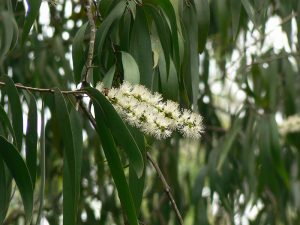 CAJEPUT (also TEA TREE)
CAJEPUT (also TEA TREE)Leaves: Tincture and tea – expectorant, laryngitis, bronchitis, cystitis, psoriasis, fever, aching muscles and joints.
Tincture/ointment: wound healing, antiseptic
Active ingredients: Essential oil, cineol
Not to be confused with Queen Anne’s Lace, which is poisonous.
Tea made from the fresh herb – diuretic, chronic kidney disease, bladder infection – and the crushed bruised seeds – colic, flatulence, coughs, sores and ulcers, colds, ‘flu, stimulates liver function.
Crushed bruised seeds in an ointment – antiseptic, antibacterial, cleansing, hydrating, anti-ageing, good for acne, mature skin and wound healing.
Active ingredients: Essential oils
Growing – Soil: well drained, light, sandy, heavy, clay, moist, chalky, alkaline. Plant in full sun.
Seed harvest –ripe when turning tannish-brown from green; ripe seeds detach from the plant; cut stems several inches from umbels, allow to dry. Attracts bees and other pollinating insects and birds.
Plant (cordial) – carminative, flatulence, soothes stomach, digestive disorders.
Seed (distilled water) – flatulence/colic in children.
General actions – antispasmodic, stimulates digestion, expels intestinal gas, eases gastric spasms, nervous dyspepsia, painful diarrhoea, coughs, bronchitis, sore throat, expectorant, diuretic.
Often used to flavour or mask unpleasant tastes. Leaves and seeds share similar properties.
NB: Easily confused with similar looking poisonous varieties.
Active ingredients: essential oil, carvone
Growing: waste lands
Side note: It takes 6lb of unbruised seeds to produce 4oz of essential oil.
Seeds can be chewed, or ground and powdered and mixed with honey – good for colic (especially when combined with orange, cinnamon, cloves and caraway as a tea).
Tea: Flatulence, indigestion, warming
Keep seeds in pericarps for freshness, best value and flavour – use as and when required.
Active ingredients: essential oils, fixed oil, salt of potassium, starch, nitrogenous mucilage, acrid resin, ash.
Juniperus virginiana – astringent, diuretic, emmenogogue.
Infuse 1oz to a pint of water: consume a tablespoon at a time – astringent, diuretic, coughs, fevers, rheumatism.
Apply as a tincture. Leaves can be added to ointment for topical application.
NB: Do not use during pregnancy.
Active ingredients: essential oils, pinipicrin (bitter), pinitannic acid, sugar, gelatinous matter, wax, resin, thujin.
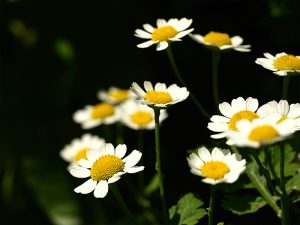 CHAMOMILE ROMAN
CHAMOMILE ROMANTea from dried flowers – nervousness, soothing, indigestion, heartburn, flatulence (especially combined with ginger), sluggish intestinal action, nausea, appetite stimulant and digestive tonic, headaches, diuretic. Diarrhoea in children.
Tincture/concoction – hair conditioner.
Active ingredients: essential oil especially chamazules, bitters, coumarin, flavone-glycosides.
Growing: gardens and waste lands.
Berries pounded/crushed to form tincture – pains in limbs and weakness. Reduces sexual desire.
Active ingredients: essential oils, saponins, irdiod glycocides.
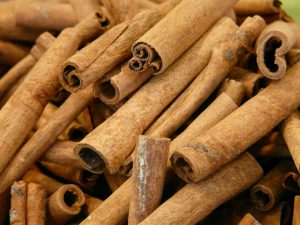 CINNAMON LEAF / BARK
CINNAMON LEAF / BARKInfusion: Carminative, astringent, stimulant, antiseptic.
Powder (mixed with honey) and infusion relieves vomiting, flatulence, diarrhoea.
Active ingredients: essential oil, tannin, mucilage, sugar
Toxic to pets
Environmental / Topical use only in an ointment or non-perfumed cream, or vegetable oil – Insect repellant.
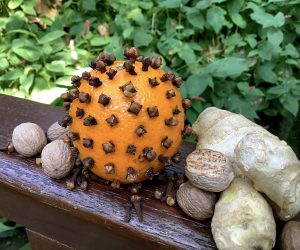 CLOVE BUD
CLOVE BUDVery carminative, stimulating, astringent.
Powder or infusion for nausea, flatulence, dyspepsia, toothache, bronchitis.
Infusion: 5 to 30 drops. Essential oil extract: 1 to 5 drops
Active ingredients: essential oils, gallotannic acid, caryophyllin, eugenin, gum resin, fibre.
Tea: Fresh leaves and fruit – stimulant, windy colic.
Also used to disguise less pleasant flavours.
Active ingredients: essential oils, bitters, tannins.
Growing: well-drained fertile, light, sandy soil in full sun or part shade. Plant with basil.
Cones and needles, soaked/boiled in water, for topical use only – fungal infections, respiratory conditions, acne, dandruff, inflammation, improve appearance of scar tissue, varicose veins.
Active ingredients: essential oils
Leaves – tea or tincture – stimulant, antiseptic, colds, ‘flu.
Gargle for respiratory and throat antiseptic; use in moderation, do not swallow.
Ointment: antiseptic skin care
Active ingredients: essential oils, eucolyptol.
Fruits – gripe water – carminative, flatulence, digestive problems
Supports fasting.
Fennel tea from bruised seeds. 1 teaspoon crushed fruits in 250ml boiling water, leave to stand for 10 minutes.
NB: fruits can be confused with poisonous species, so ensure you obtain fruits from a reputable supplier.
Active ingredients: essential oils, fatty oils.
Growing: sunny, well- drained soil, allow flowers to blossom and fade, remove seeds when fully ripe. Do not grow next to dill, grow away from other plants (may inhibit other plants growth).
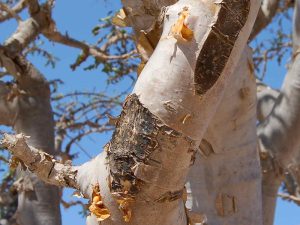 FRANKINCENSE (resin)
FRANKINCENSE (resin)Tea or tincture – tumors, ulcers, dysentery, vomiting, fevers.
Ointment – skin healing
Khol is made from charred frankincense
Active ingredients: high content of essential oil, water soluble gum, bassorin, boswellic acid, alibanoresin.
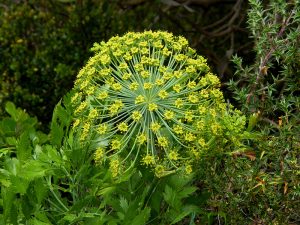 GALBANUM
GALBANUMStimulant, expectorant for bronchitis, antispasmodic, relieves air passage/eases breathing, inflammatory swelling, emotionally calming.
Active ingredients: essential oil, gum resin, mineral constituents, umbelliferine, galbaresino-tannol.
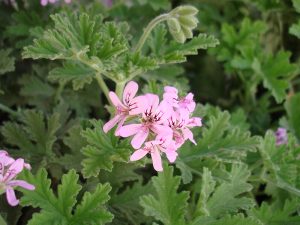 GERANIUM
GERANIUMTincture and tea: astringent, tonic, diarrhoea, colic, dysentery, inflammation, pain relief, respiratory disorders, aids digestion, skin care.
Active ingredients: essential oils, citronellol, geraniol, linalool, menthone, isomenthone, limonene, pinene and methyl eugenol, flavonoids, tannins, alkaloids.
Stimulant, carminative, dyspepsia, flatulence, diarrhoea.
Tea/infusion: ½ oz bruised or powdered root to 1 pint boiling water, 1 fluid oz taken at a time.
Active ingredients: essential oils, acrid soft resin, gum, starch, lignin, asmazone, acetic acid, acetate of potassa, sulphur.
Fruit: antioxidant, source of vitamin C, A, Potassium, Thiamine, Folate, Magnesium. Appetite control, may aid insulin resistance, hydrating.
Tea/infusion – stimulates digestive juices and strengthens pancreas.
Active ingredients: essential oils, bitters, tannins, flavonoids.
Expectorant for coughs and throat infections, flatulence and indigestion; stimulant, eases rheumatism.
Infusion: boil 2 teaspoons in 250ml water, infuse for 5 minutes. Drink 2 cups daily
Active ingredients: essential oils, tannins, bitter glycosides.
Growing: dry rocks, calcareous scree. Sow seeds just beneath the soils surface indoors or directly in outside (garden) 8 – 10 weeks before the last frost. Plants can be divided in autumn.
Flowers: Spanish or Catalonian jasmine used in perfumery or added to cream or lotion for skin care.
Active ingredients: essential oils
Tea: diuretic, stomachic, carminative, diarrhoea, indigestion, flatulence, kidney and bladder disease, rheumatism.
Infuse 1oz berries in 1 pint boiling water, consume over 24 hours.
Active ingredients: essential oils, resin, sugar, gum, water, lignin, saline.
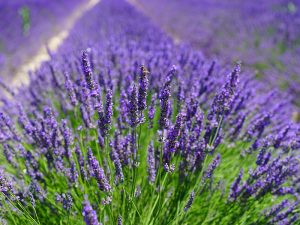 LAVENDER (Angustifolia)
LAVENDER (Angustifolia)Tea: 1 teaspoon to 250ml water, slowly bring to boil and simmer. Drink one cup in morning and afternoon – sedative, migraine, exhaustion, nervous conditions.
Tincture/infusion: eczema, psoriasis, insect bites, burns, sore throat.
Active ingredients: essential oil, tannins
Growing: warm, well drained dry sites, neutral to alkaline soil, in full sun, flowers June to August.
Juice: anti-scorbutic, cools fevers. Source of vitamin C, aids weight loss, aids digestion, prevents kidney stones, aids absorption of iron from plant foods
Peel: tonic
Active ingredients: Peel – essential oil, bitters. Juice – citric acid, sugar, gum, a little potash, naringenin.
Tea: cut fresh stalks into small pieces, pour on 1 cup fresh boiling water, leave to stand for at least 5 minutes, strain (to remove plant matter) into a tea cup – digestive tract spasms, stomach ache, bloating, pain, cough, aching joints, colds, exhaustion, reduces inflammation.
Active ingredients: essential oils, especially citral.
See orange
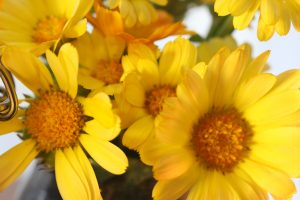 MARIGOLD (CALENDULA)
MARIGOLD (CALENDULA)Tincture/infusion – anti-septic, anti-fungal, diaphoric, pain, swelling, insect stings, ulcers, varicose veins, sprains, wounds, inflammation.
Leaves are eaten in salads.
Active ingredients: essential oils, saponins, bitters, carotenoids, flavonoids.
Tea infusion: dried or fresh leaves 1 teaspoon in 250ml of boiling water for 10 minutes – sprains, bruises, stimulant, carminative, diaphoric, mild tonic, emmenogogue, toothache, swelling, colic, nervous headaches
Active ingredients: essential oils, bitters, tannins.
Growing: sow indoors February to May, or until danger of frost passed. Plant outside in sunny sheltered spot in well-drained soil or container. Do not over water. Limit moisture in winter, keep in sheltered spot. Cut back leaves after flowers fade in summer.
Tea infusion: 2 teaspoons in 250ml boiling water, leave to stand for 10 minutes, drink 3 cups daily – nervous complaints of the stomach, intestine and heart; anti-depressant; wound healing.
Active ingredients: essential oils, bitters, tannins.
Growing: well drained moist soil, gardens, waste-land, in full sun or partial shade. Propagate by seed or plant division in Autumn.
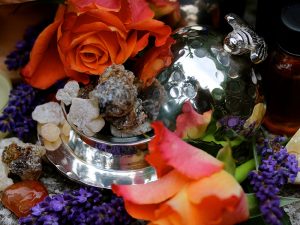 MYRRH (resin)
MYRRH (resin)Tea or tincture: astringent, healing, tonic, stimulant, expectorant, stimulates mucous tissues, stomachic, carmative, aids flow of gastric juices.
Active ingredients: essential oils, resin, gum, ash, salts, sulphates, benzoates, malates, potassium acetate.
Tea or tincture – expectorant for bronchitis and lung complaints, gingivitis, antiseptic, astringent
Active ingredients: essential oils, terpenes, bitter, tannins.
See orange.
Tea or grated/powdered and added to honey – stimulant, euphoric, flatulence, nausea.
Active ingredients: essential oils, lignin, stearin, starch, gum.
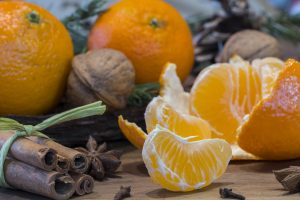 ORANGE
ORANGEFlavouring. Infusion of dried flowers (Neroli) used as mild nervous stimulant.
Orange peel – flavouring, bronchitis (tea)
Active ingredients: essential oils, glucosides, hesperidin, isohesperidin, aurantiamarin, aurantiamaric acid, resin.
Tea infusion: 1 to 2 teaspoons in 250ml in boiling water for 5 minutes. Drink 1 to 2 cups per day, also use as gargle or wash – improve appetite, digestion, flatulence, coughs, whooping cough, asthma, mouth infection, wounds, soothes nerves, headaches, encourages menstruation.
Active ingredients: essential oils, tannins, bitters.
Growing: see marjoram.
Tea: exhaustion, stress, supports digestive and respiratory system.
Active ingredients: essential oils.
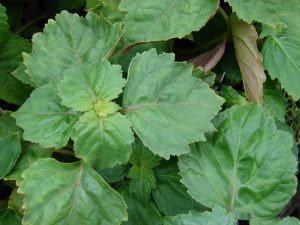 PATCHOULI
PATCHOULIMainly used topically: leaves added to ointment (mainly used as an essential oil, again added to vegetable oil or ointment) – loss of appetite, aids sleep, nervous attacks, prophylactic (prevents disease) properties.
Tea or crushed and added to food – stimulant (general), carminative, febrifuge, mucous membrane stimulant (rectum), constipation, urinary organs, aids digestion, nausea, arthritic conditions diarrhoea.
Active ingredients: essential oils, piperine, resin.
See mint
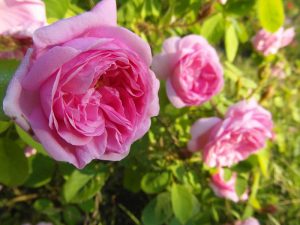 ROSE OTTO / DOG ROSE
ROSE OTTO / DOG ROSERose water: Astringent, fever, infection, inflammation, stomachic, liver and heart complaints, headaches, cooling, sore throat, gum infection, ear infection (especially with chamomile), skin care.
Dog rose: diuretic, kidney stones, tired eyes.
Active ingredients: dog rose – essential oils, tannins, fruit acids, carotenoids, rutin, vitamin C.
Hungary Water – infused for headaches, colic, colds, nervous diseases, nervous depression.
Tea infusion: 1 teaspoon in 250ml in cold water, slowly bring to boil, simmer. Drink one cup morning and afternoon – astringent, tonic, diaphoretic, stimulant, hair care, exhaustion (especially after infection).
Active ingredients: essential oils, tannins.
Growing: well drained soil in full sun. Grow in container for a couple of years before planting out in garden. Cut back annually. Do not allow over wet / moisture in winter.
Tea infusion: 1 to 2 teaspoons in 250ml cold water, bring to boil, simmer for 10 minutes – carminative, tonic, aperitive, astringent, anti-spasmodic, balsamic.
Tincture, fresh and dried herbs – gargle.
Active ingredients: essential oils, tannin, bitters, flavonoids.
Tea/infusion – chronic bronchitis, chronic cystitis.
Active ingredients: essential oils.
Tea/infusion – stimulant, rheumatism, pulmonary infections, wound healing, bruises, ruptures, inner wounds, pain and difficulty breathing, emmenagogue.
Active ingredients: essential oils, resin, tannins..
Tea/tincture: Boil 1 teaspoonful in 250ml water (sweeten with honey for coughs) – expectorant and mild anesthetic for coughs, whooping cough, acute and chronic bronchitis, digestive disorders, antiseptic, antispasmodic, tonic, carminative.
Active ingredients: essential oils, especially thymol and carvacrol, tannins bitters, flavones.
Growing: sow indoors from early March, plant out May to June in a warm sunny spot in well drained soil – do not over water, especially in winter.
Tea/tincture or eaten as food. Herbal medicine for: rheumatoid arthritis, chronic anterior uveitis, conjunctivitis, skin cancer, small pox, chicken pox, wound healing, urinary tract infections, and liver ailments (Dixit, Jain, Joshi 1988).
Also used for digestive disorders: to reduce flatus, jaundice, menstrual difficulties, and colic; for abdominal pain and distension (Bundy et al. 2004); and for dyspeptic conditions including loss of appetite, postprandial feelings of fullness, and liver and gallbladder complaints.
Anti-inflammatory, choleretic, antimicrobial, and carminative actions (Mills and Bone 2000).
The main clinical targets of turmeric are the digestive organs: in the intestine, for treatment of diseases such as familial adenomatous polyposis (Cruz-Correa et al. 2006); in the bowels, for treatment of inflammatory bowel disease (Hanai and Sugimoto 2009); and in the colon, for treatment of colon cancer (Naganuma et al. 2006).
For arthritis, dosages of 8–60 g of fresh turmeric root three times daily have been recommended (Fetrow and Avila 1999).
For dyspepsia, 1.3–3.0 g of turmeric root is recommended. No known interaction of drugs with turmeric has been reported by the monographs of the German regulatory authority, Commission E (Blumenthal, Goldberg, and Brinckmann 2000). https://www.ncbi.nlm.nih.gov/books/NBK92752/
Active ingredients:
Components responsible for odour: turmerone, arturmerone, zingiberene.
Whole rhizome contains: four new polysaccharides-ukonans along with stigmasterole, β-sitosterole, cholesterol, and 2-hydroxymethyl anthraquinone (Kapoor 1990; Kirtikar and Basu 1993). Nutritional analysis showed that 100 g of turmeric contains 390 kcal, 10 g total fat, 3 g saturated fat, 0 mg cholesterol, 0.2 g calcium, 0.26 g phosphorous, 10 mg sodium, 2500 mg potassium, 47.5 mg iron, 0.9 mg thiamine, 0.19 mg riboflavin, 4.8 mg niacin, 50 mg ascorbic acid, 69.9 g total carbohydrates, 21 g dietary fiber, 3 g sugars, and 8 g protein (Balakrishnan 2007). Turmeric is also a good source of the ω-3 fatty acid and α-linolenic acid (2.5%; Goud, Polasa, and Krishnaswamy 1993).
Tincture (dried or fresh roots): antispasmodic, nervine, carminative, stimulant; insomnia, nervousness, trembling, stress, headaches.
Adults and the Elderly:
For day-time use: Take one 5 ml teaspoonful in water or fruit juice when necessary, up to three times a day.
For evening use: Take one 5ml teaspoonful in water or fruit juice half to one hour before bedtime, with an earlier dose during the evening if necessary.
Take continuously for 2-4 weeks for full effect.
Tea: I teaspoon dried root in 250ml boiling water, leave to steep for ten minutes. Drink 30 to 60 minutes before bed as sleep aid, or sip through day as a nervine – may cause drowsiness.
Active ingredients:
Roots: Essential oils (very complex) – valerianic, formic and acetic acids, borneol (alcohol), and pinene. Alkaloids – Chararine and Valerianine, glucosides, resin. Anti-oxidants – hesperidin, linarin.
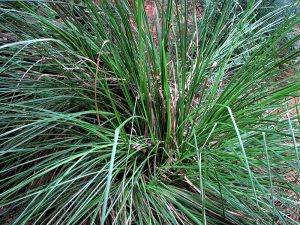 VETIVERT
VETIVERTRoot – tea/infusion (with lemon and honey) – constipation and flatulence, aids digestion; sedative, uplifting, anxiety, insomnia, restlessness, panic, rheumatism, wound healing, insect repellant, coolant, excessive sweating, fever.
Active ingredients: essential oils, Allokhusiol, benzoin acid, cycloccapacamphene, epikhusinol, epizizanal, 2-epizizanone, B-eduesmol, eugenol, iskhusimol, isokhusinoloxide, isovalencenol, isovalencic, khusimyl acetate, khusinodiol, khusinol, khusitoneol, laevojujenol, levojunenol, vanillin, vertiselinenol, B- & J vetivene, vetivenic acid, vetiverol, zizanol.
(Increases the groundwater recharge capacity of soils).
Tea/infusion: 1oz (28gms) dried herbs to 1 pint (560ml) boiling water, allow to stand until warm, drink as and when required – diaphoretic, astringent, tonic, stimulant, colds, fever.
Active ingredients: essential oils, resin, tannin, gum, earthy ash (nitrates, phosphates, chlorides of potash and lime).
Topical tincture/infusion in water or vegetable oil – malaria, stomach ailments, asthma, gout, rheumatism.
Active ingredients: essential oils